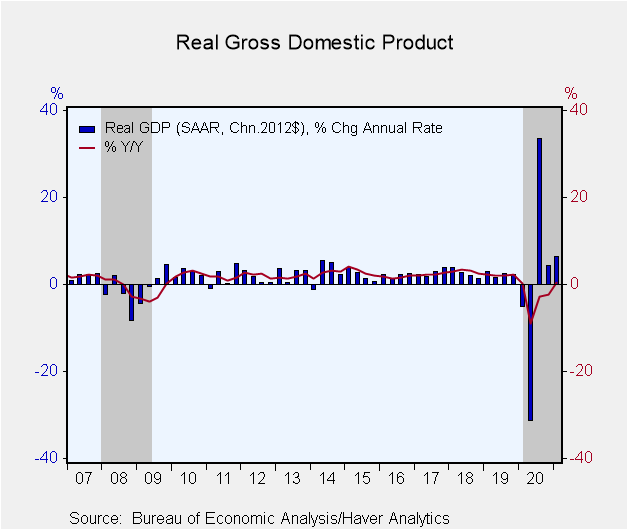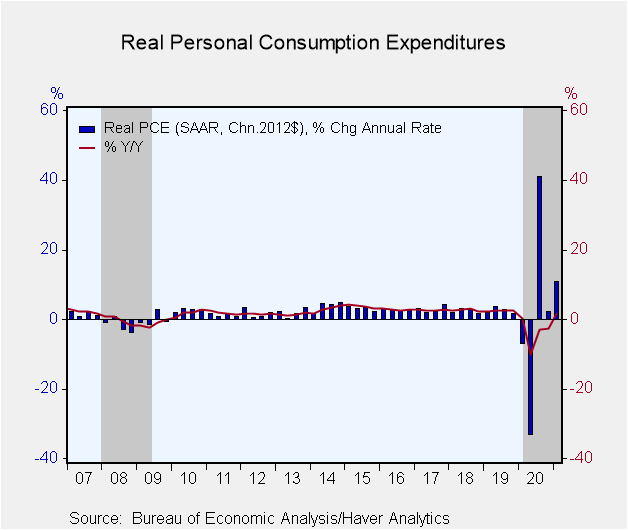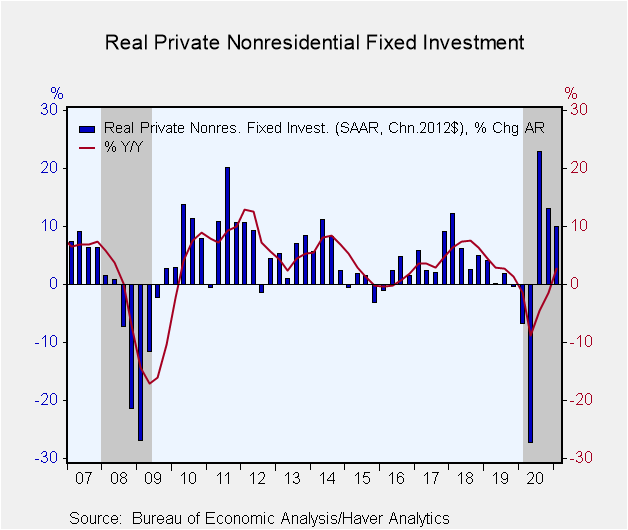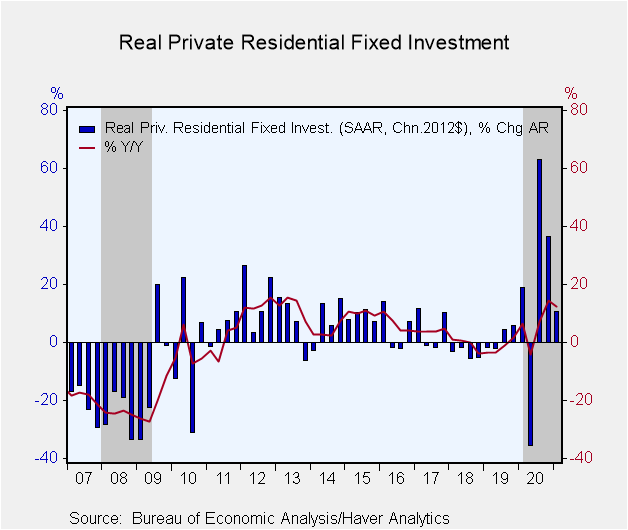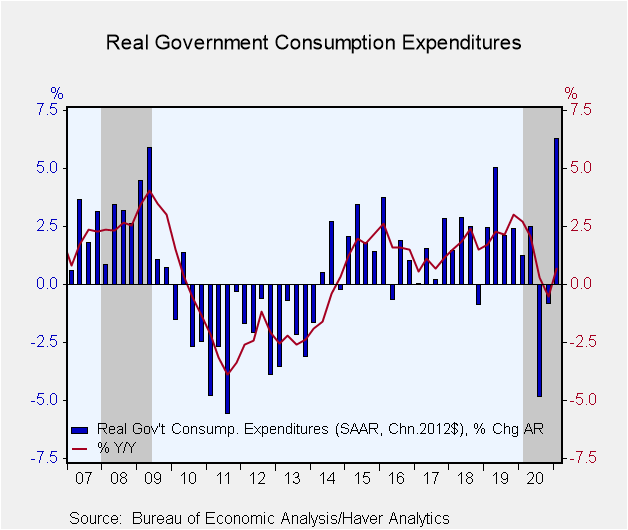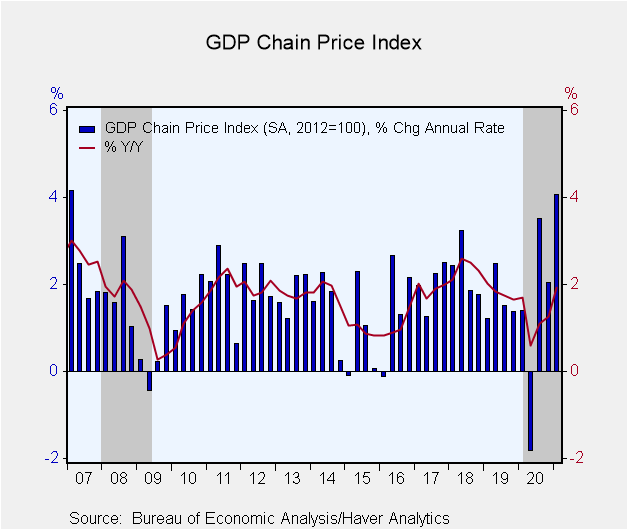 Global| Apr 29 2021
Global| Apr 29 2021U.S. GDP Growth Acceleration Paced by the Consumer in Q1'21
by:Tom Moeller
|in:Economy in Brief
Summary
• Cash payments, vaccinations and reduced business restrictions lift consumer spending. • Business investment surges, again • Price index is lifted by energy and housing. Trillions of dollars in government aid as well as widespread [...]
• Cash payments, vaccinations and reduced business restrictions lift consumer spending.
• Business investment surges, again
• Price index is lifted by energy and housing.
Trillions of dollars in government aid as well as widespread COVID-19 shots prompted consumers to spend more last quarter. Real GDP surged 6.4% (SAAR) during Q1'21 (0.4% y/y) following a 4.3% rise during the previous quarter. A 6.0% gain had been expected in the Action Economics Forecast Survey.
Domestic final sales growth more than doubled q/q to 9.8% (2.0% y/y) as consumer spending surged 10.7% (1.6% y/y) following a 2.3% Q4 rise. Durable goods spending jumped 41.4% (+25.9% y/y) after easing 1.1% in Q4. Motor vehicle buying increased 51.5% (28.3% y/y) after easing 0.6%. Furniture & appliance purchases gained 45.2% (20.7% y/y) and purchases of recreational goods & vehicles rose 28.1% (27.8% y/y) after falling 1.5%. Nondurable goods spending strengthened 14.4% (5.8% y/y) following a 1.6% decline. Spending on clothing surged 33.8% (18.5% y/y) after edging 1.6% higher in Q4 while food & beverage outlays gained 15.2% (2.9% y/y) after a 2.5% decline. Outlays on services increased 4.6% (-3.2% y/y) following a 4.3% rise. Restaurant & hotel spending surged 25.9% (-8.3% y/y) while recreation outlays gained 26.0% (-21.7% y/y), strong for the third straight quarter. Outlays on housing & utilities improved 1.2% (1.7% y/y) after edging 0.6% higher.
Business fixed investment grew 9.9% (2.7% y/y), the third straight quarter of strong growth. Structures investment fell 4.8% (-16.4% y/y), the sixth straight quarter of sharp decline. Equipment investment surged 16.7% (12.1% y/y) following two quarters of strong growth. Information processing equipment grew 34.4% (30.6% y/y) after a 13.0% rise. Investment in intellectual property strengthened 10.1% (3.9% y/y), about the same as in Q4'20.
Residential investment surged 10.8% (12.3% y/y) to the highest level since the first quarter of 2007.
Government spending advanced 6.3% (0.7% y/y), the strongest increase since Q1 2002. Federal government spending surged 13.8% (5.4% y/y) after falling for two straight quarters. State & local expenditures rose 1.7% (-2.1% y/y) following three straight quarterly declines.
Inventory decumulation sapped 2.6 percentage points from GDP growth last quarter following two quarters of strong accumulation. International trade deficit deterioration reduced GDP growth by 0.9 percentage points following two quarters of negative effects. Exports fell 1.1% (-8.9% y/y) after rising strongly for two consecutive quarters. Imports rose 5.7% (5.0% y/y) following two quarters of even stronger gain.
The GDP chain price index rose 4.1% (1.9% y/y), the strongest gain since Q1'07. The rise in the PCE price measure accelerated to 3.5% (1.7% y/y) while the business fixed investment price index rose 0.5% (0.4% y/y) after a 0.2% gain. The residential investment price index surged 11.4% (7.0% y/y) while the public sector price index strengthened 6.2% (2.4% y/y), equaling the largest gain since early 2007.
The GDP figures can be found in Haver's USECON and USNA database. USNA contains virtually all of the Bureau of Economic Analysis' detail in the national accounts. Both databases include tables of the newly published not seasonally adjusted data. The Action Economics consensus estimates can be found in AS1REPNA.
| Chained 2012 $ (%, AR) | Q1'21 | Q4'20 | Q3'20 | Q1'21 Y/Y | 2020 | 2019 | 2018 |
|---|---|---|---|---|---|---|---|
| Gross Domestic Product | 6.4 | 4.3 | 33.4 | 0.4 | -3.5 | 2.2 | 3.0 |
| Inventory Effect (%-point) | -2.6 | 1.4 | 6.6 | 0.0 | -0.6 | 0.0 | 0.2 |
| Final Sales | 9.2 | 2.9 | 25.9 | 0.4 | -2.9 | 2.2 | 2.8 |
| Foreign Trade Effect (%-point) | -0.9 | -1.5 | -3.2 | -1.6 | -0.1 | -0.2 | -0.3 |
| Domestic Final Sales | 9.8 | 4.4 | 29.8 | 2.0 | -2.7 | 2.3 | 3.0 |
| Demand Components | |||||||
| Personal Consumption Expenditure | 10.7 | 2.3 | 41.0 | 1.6 | -3.9 | 2.4 | 2.7 |
| Nonresidential Fixed Investment | 9.9 | 13.1 | 22.9 | 2.7 | -4.0 | 2.9 | 6.9 |
| Residential Investment | 10.8 | 36.6 | 63.0 | 12.3 | 6.1 | -1.7 | -0.6 |
| Government Spending | 6.3 | -0.8 | -4.8 | 0.7 | 1.1 | 2.3 | 1.8 |
| Chain-Type Price Index | |||||||
| GDP | 4.1 | 2.0 | 3.5 | 1.9 | 1.2 | 1.8 | 2.4 |
| Personal Consumption Expenditure | 3.5 | 1.5 | 3.7 | 1.7 | 1.2 | 1.5 | 2.1 |
| Less Food & Energy | 2.3 | 1.3 | 3.4 | 1.5 | 1.4 | 1.7 | 2.0 |
| Nonresidential Investment | 0.5 | 0.2 | 0.1 | 0.4 | 0.5 | 1.3 | 0.9 |
| Residential Investment | 11.4 | 6.5 | 9.5 | 7.0 | 3.3 | 2.8 | 5.6 |
Tom Moeller
AuthorMore in Author Profile »Prior to joining Haver Analytics in 2000, Mr. Moeller worked as the Economist at Chancellor Capital Management from 1985 to 1999. There, he developed comprehensive economic forecasts and interpreted economic data for equity and fixed income portfolio managers. Also at Chancellor, Mr. Moeller worked as an equity analyst and was responsible for researching and rating companies in the economically sensitive automobile and housing industries for investment in Chancellor’s equity portfolio. Prior to joining Chancellor, Mr. Moeller was an Economist at Citibank from 1979 to 1984. He also analyzed pricing behavior in the metals industry for the Council on Wage and Price Stability in Washington, D.C. In 1999, Mr. Moeller received the award for most accurate forecast from the Forecasters' Club of New York. From 1990 to 1992 he was President of the New York Association for Business Economists. Mr. Moeller earned an M.B.A. in Finance from Fordham University, where he graduated in 1987. He holds a Bachelor of Arts in Economics from George Washington University.


